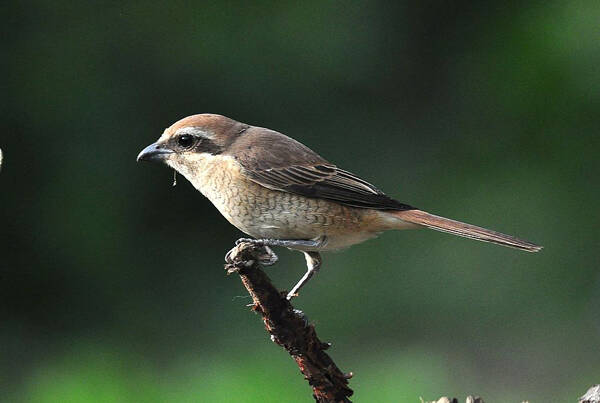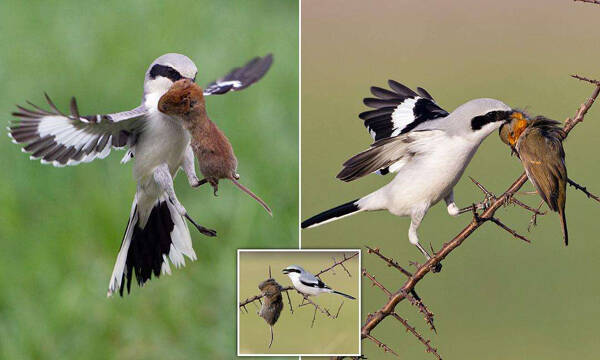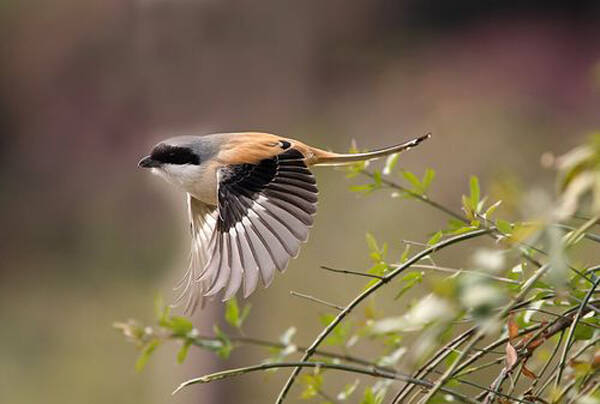Lanius
IUCN
LCBasic Information
Scientific classification
- name:Lanius
- Scientific Name:Lanius,Brown Shirk,Butcher Bird,Butcher bird, Hubula, quail, shrike, shrike, shrike
- Outline:Songbird
- Family:Passeriformes Shrike Shrike
Vital signs
- length:20-30cm
- Weight:50-100g
- lifetime:9-11years
Feature
It has a ferocious temperament and is known as the "bird of prey among birds".
Distribution and Habitat
It is mainly distributed in San Clemente Island, Uluguru Bush Shrike in Uluguru Mountain, Tanzania, and China.
The Shrike native to San Clemente Island, USA is an endangered species; the Uluguru Bush Shrike native to Uluguru Mountain, Tanzania is also in danger of extinction. There are red-tailed shrikes, brown-backed shrikes, red-headed shrikes and tiger-striped shrikes in Taiwan, China.
Most of them live in open woodlands on hills. They often live on treetops, hunt on the ground, and return to branches after catching.
Appearance
It is a small to medium-sized passerine with a large and strong beak with a sharp hook and notch at the tip and well-developed whiskers. The wings are short and round. The tail is long. The head is large, and most species have a wide black eye stripe. The plumage of males and females is similar or different. The wings of the shrikes are short and round, usually with a convex tail; the feet are strong, and the toes have sharp hooks.
Details
Brown Shirk or Butcher Bird (scientific name Lanius) is a small carnivorous bird, most of which are migratory birds in my country. .

The most common species are red-tailed shrike, tiger-striped shrike, brown-backed shrike, and gray shrike. Shrikes are smaller than robins, with gray or light brown feathers, black wings and tails with white spots, and a distinct black ring around the eyes. Shrikes in Europe are mostly red and brown; the greater shrikes in Canada and the United States, also called northern shrikes, are the most widely distributed of the shrikes; the shrikes are native to Africa, and there are about 40 species. The body length is about 16 to 21 cm. The feathers are brightly colored, the beak is not as sharp as other shrikes, and the tail has long and soft feathers. The four-color bush shrikes have green upper bodies and golden lower bodies. The red throat and black edges are very beautiful.
The shrike is ferocious by nature. It often stands high and looks down, waiting for an opportunity to catch insects, frogs, lizards, small birds and mice. It often hangs its prey on thorny trees, kills them with the help of the thorns, tears them into pieces and eats them. Sometimes it does not eat all of them, but uses this method to store food, so some people call it the butcher bird.

Since the living environment of the shrike is open grasslands and pastures, with the expansion of human cities and mechanized farming of pastures, the living environment of the shrike is getting smaller and smaller, which has also led to a decrease in the number of shrikes year by year. The chances for us to see this strong and unique bird are also getting fewer and fewer.

Legend has it that during the reign of King Xuan of Zhou, the wise minister Yin Jifu listened to the slander of his second wife and accidentally killed his beloved son Boqi left by his ex-wife. Boqi's younger brother Bofeng mourned his brother's misfortune and wrote a sad poem. After listening to it, Yin Jifu regretted it very much and was in great sorrow. One day, Yin Jifu saw a bird he had never seen before in the suburbs. It stopped on a mulberry tree and chirped at him. The sound was very sad and mournful. Yin Jifu suddenly thought that the bird was the soul of his son Boqi, so he said: "Boqi Laohu, if you are my son Boqi, please fly over and land on my carriage." As soon as he finished speaking, the bird flew over and landed on the carriage. So Yin Jifu took the bird home. After arriving home, the bird stopped on the well and cried across the house. Yin Jifu pretended to shoot the bird, picked up a bow and arrow and shot his second wife to comfort Boqi. Although the story is close to mythology, the name of the shrike bird comes from the phrase "Boqi Laohu". In addition, the idiom "Laoyan Fenfei" also comes from the shrike bird. Bird culture has a long history among the people.
The shrike is a national protected animal and belongs to the national three-protected animal. Therefore, it is not allowed to illegally hunt and sell more than 20 of them in life, otherwise it will be illegal. The shrike native to San Clemente Island in the United States is an endangered animal. The Uluguru bush shrike native to Uluguru Mountain in Tanzania is also in danger of extinction.
Protect wild animals and eliminate game.
Maintaining ecological balance is everyone's responsibility!








